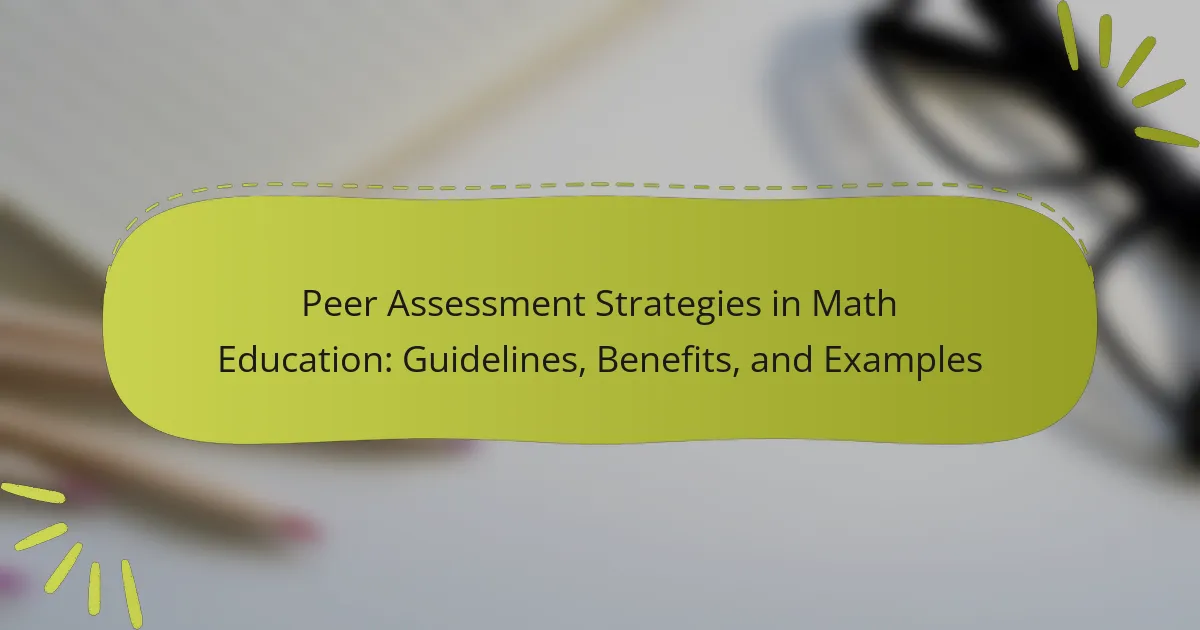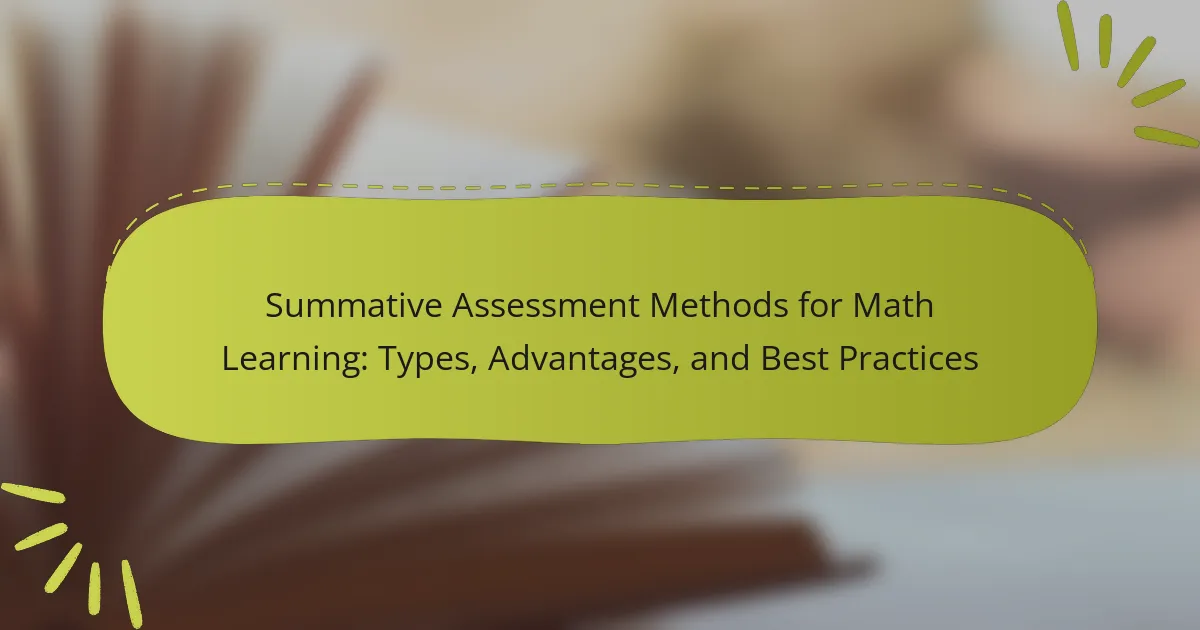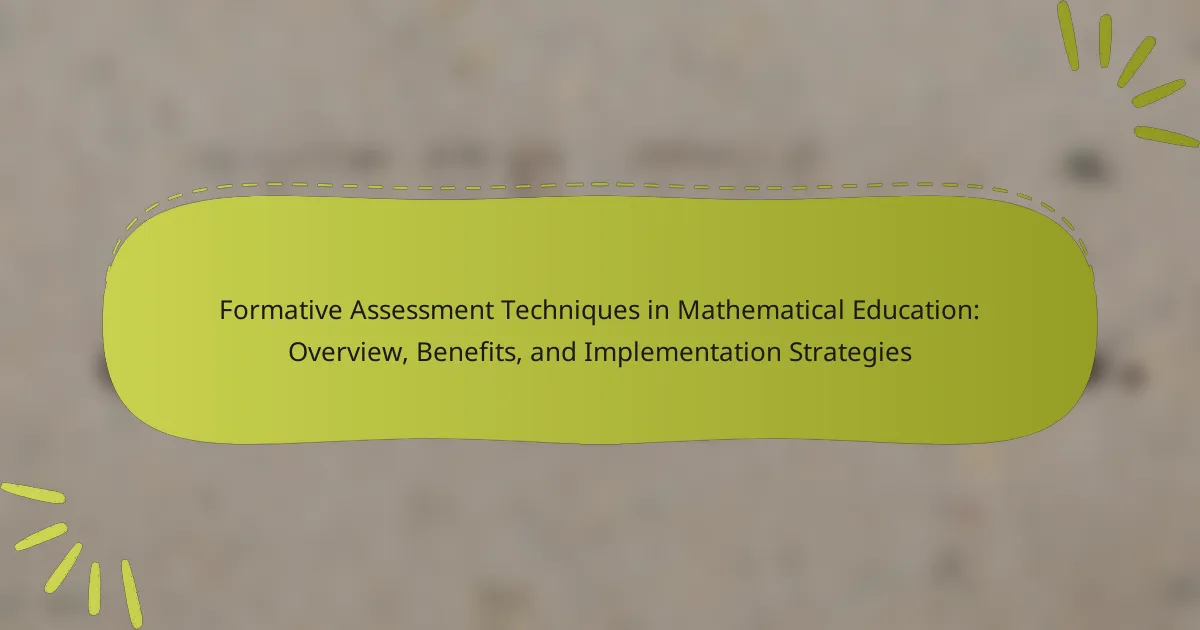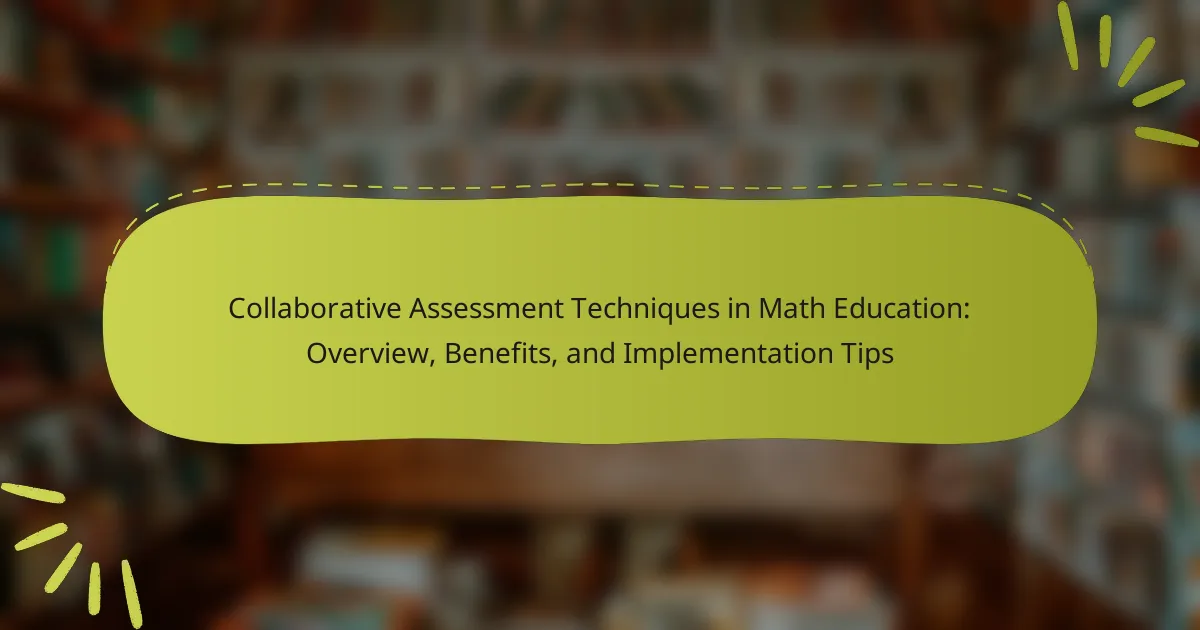Performance-based assessment in mathematics evaluates students’ skills through real-world tasks, measuring both knowledge and application abilities. This assessment method emphasizes problem-solving, critical thinking, and collaboration, allowing students to showcase their understanding through projects and presentations. Research highlights the advantages of performance-based assessments, including increased student motivation, engagement, and a deeper insight into their reasoning processes. Effective assessments must align with learning objectives, be authentic, accommodate diverse learning styles, have clear evaluation criteria, and provide timely feedback. However, challenges such as subjectivity in grading, time constraints, and resource requirements can impact their effectiveness in accurately measuring student understanding and skills.
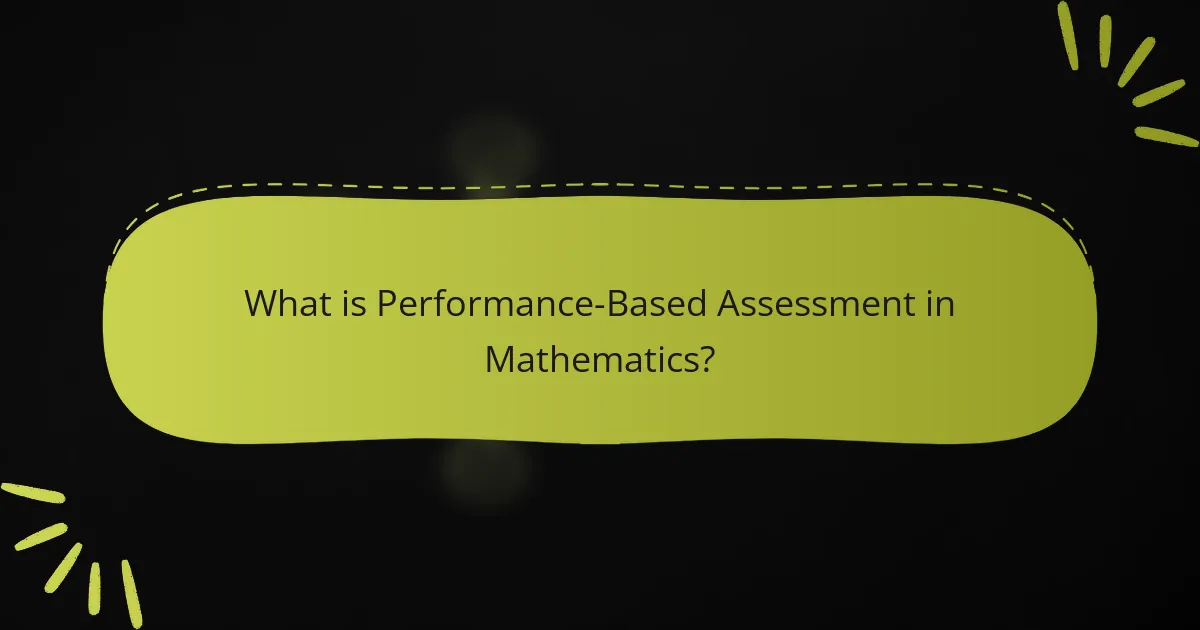
What is Performance-Based Assessment in Mathematics?
Performance-based assessment in mathematics evaluates students’ abilities through real-world tasks. This assessment measures not only knowledge but also application skills. It often involves problem-solving, critical thinking, and collaborative work. Students demonstrate their understanding by completing projects or presentations. Research indicates that this approach enhances learning engagement. Studies show that performance-based assessments can improve student motivation and achievement. They provide insights into students’ thought processes and reasoning. Overall, this method offers a comprehensive view of a student’s mathematical capabilities.
How does Performance-Based Assessment differ from traditional assessments?
Performance-Based Assessment differs from traditional assessments in its focus on real-world application of skills. Traditional assessments typically measure knowledge through standardized tests and quizzes. These methods often emphasize memorization and recall of facts. In contrast, Performance-Based Assessment evaluates students through tasks that simulate real-life challenges. This approach assesses critical thinking, problem-solving, and the ability to apply knowledge in practical situations. Studies show that Performance-Based Assessment can lead to deeper learning and engagement. Research by the National Research Council indicates that such assessments provide more meaningful insights into student capabilities.
What are the key characteristics of Performance-Based Assessment?
Performance-Based Assessment evaluates students through real-world tasks. These assessments focus on students’ ability to apply knowledge and skills in practical situations. They often require critical thinking, problem-solving, and collaboration. Performance-Based Assessments can include projects, presentations, and demonstrations. They provide a holistic view of student learning. Feedback is typically detailed and specific, guiding improvement. This type of assessment promotes deeper understanding and engagement in the learning process. Research shows that Performance-Based Assessment can enhance student motivation and achievement.
Why is Performance-Based Assessment important in mathematics education?
Performance-Based Assessment is important in mathematics education because it evaluates students’ understanding through real-world applications. This type of assessment measures not only knowledge but also the ability to apply mathematical concepts in practical situations. It encourages critical thinking and problem-solving skills, essential for mastering mathematics. Research indicates that students perform better when engaged in performance-based tasks. For instance, a study by the National Council of Teachers of Mathematics found that performance assessments lead to deeper learning outcomes. These assessments also provide educators with valuable insights into student progress and instructional effectiveness.
What are the main components of Performance-Based Assessment?
The main components of Performance-Based Assessment are tasks, criteria, and feedback. Tasks are activities that require students to demonstrate their knowledge and skills in real-world scenarios. Criteria are the standards used to evaluate student performance on these tasks. Feedback provides students with information on their strengths and areas for improvement based on their performance. These components work together to create an assessment that is meaningful and reflective of actual learning.
What types of tasks are included in Performance-Based Assessment?
Performance-Based Assessment includes various types of tasks such as problem-solving, projects, and presentations. These tasks require students to demonstrate their knowledge and skills in real-world contexts. For example, problem-solving tasks may involve applying mathematical concepts to solve practical problems. Projects often require students to explore mathematical concepts in-depth and present their findings. Presentations allow students to communicate their understanding and reasoning effectively. These tasks assess not only content knowledge but also critical thinking and communication skills. Performance-Based Assessments provide a comprehensive evaluation of a student’s abilities in mathematics.
How are student outcomes evaluated in Performance-Based Assessment?
Student outcomes in Performance-Based Assessment are evaluated through the demonstration of skills and knowledge in real-world tasks. Evaluators assess students based on criteria such as problem-solving abilities, critical thinking, and application of concepts. Performance tasks are often used to measure these outcomes. These tasks can include projects, presentations, or practical applications in mathematics. Rubrics are commonly employed to provide clear expectations and consistent grading. Each rubric includes specific performance levels and descriptors for various skills. This method allows for a comprehensive view of student understanding. Research shows that Performance-Based Assessment can lead to deeper learning and engagement in mathematics.
What advantages does Performance-Based Assessment offer in mathematics?
Performance-Based Assessment in mathematics provides several advantages. It enhances student engagement through active participation. Students apply mathematical concepts to real-world scenarios. This approach fosters deeper understanding and retention of knowledge. It also promotes critical thinking and problem-solving skills. Performance-Based Assessment allows for diverse demonstration of skills. Students can showcase their abilities through projects, presentations, or practical applications. Research indicates that this method leads to improved academic performance. A study by Wiggins (1990) highlights the effectiveness of performance assessments in measuring student understanding.
How does Performance-Based Assessment enhance student engagement?
Performance-Based Assessment enhances student engagement by allowing learners to demonstrate their knowledge through real-world tasks. This assessment type actively involves students in the learning process. It encourages collaboration, critical thinking, and creativity. Students feel a sense of ownership over their learning. Research shows that when students engage in hands-on activities, their motivation increases. A study by the National Center for Education Statistics found that performance-based assessments lead to higher student interest and participation. These assessments also provide immediate feedback, helping students understand their progress. Overall, this approach creates a more interactive and motivating learning environment.
What skills does Performance-Based Assessment help develop in students?
Performance-Based Assessment helps develop critical thinking skills in students. It encourages them to analyze problems and devise solutions. Students learn to apply knowledge in real-world contexts. Collaboration skills are enhanced through group projects and discussions. Communication skills improve as students present their findings. Performance-Based Assessment fosters creativity by allowing innovative approaches to tasks. It also develops self-assessment skills, enabling students to reflect on their work. Research shows that such assessments lead to deeper understanding and retention of mathematical concepts.
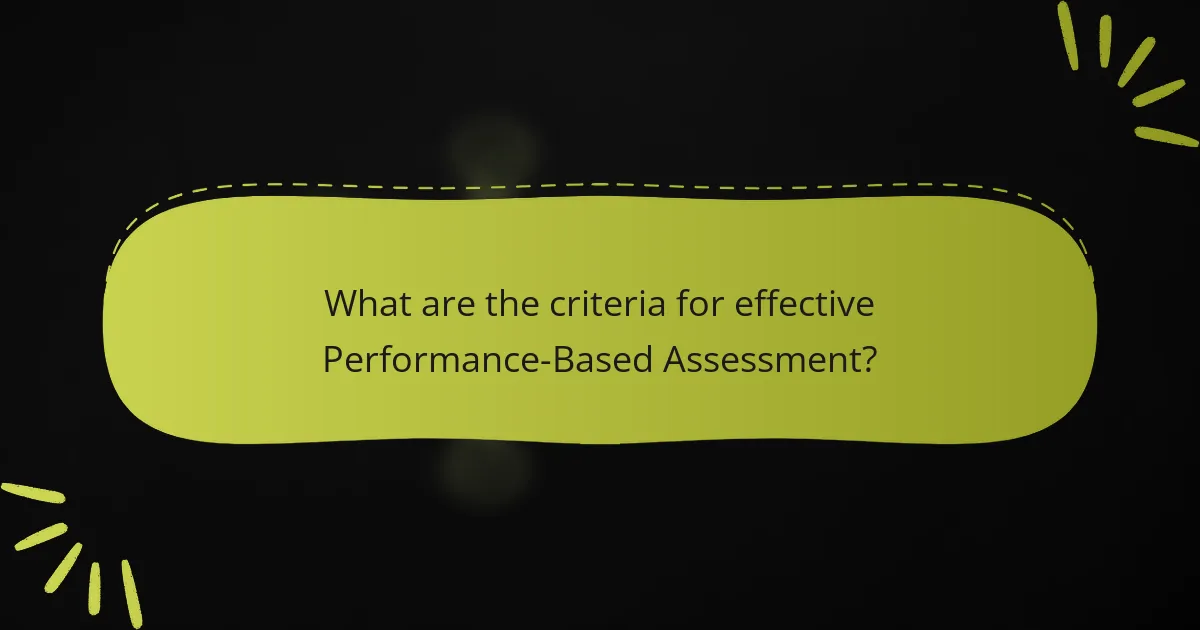
What are the criteria for effective Performance-Based Assessment?
Effective Performance-Based Assessment must meet several criteria. First, it should align with learning objectives. This ensures that assessments measure the intended skills and knowledge. Second, it needs to be authentic. Authentic assessments reflect real-world tasks relevant to students’ lives. Third, it should allow for multiple ways to demonstrate understanding. This accommodates diverse learning styles and abilities. Fourth, it requires clear criteria for evaluation. Well-defined rubrics guide students on expectations and performance levels. Finally, it should provide opportunities for feedback. Timely feedback helps students improve and learn from their experiences. These criteria enhance the effectiveness and reliability of assessments.
What factors contribute to the quality of Performance-Based Assessment?
The quality of Performance-Based Assessment is influenced by several key factors. These include clear learning objectives, which provide a framework for assessment. Authentic tasks are essential, as they reflect real-world applications of skills. Reliable scoring rubrics ensure consistency in evaluation. Feedback mechanisms contribute to student improvement and understanding. Teacher training enhances the effectiveness of assessments. Additionally, student engagement plays a crucial role in the assessment’s success. Research shows that assessments aligned with curriculum standards yield better educational outcomes.
How can clarity in assessment tasks impact student performance?
Clarity in assessment tasks significantly enhances student performance. Clear instructions reduce confusion and help students understand expectations. When students know what is required, they can focus on demonstrating their knowledge. Research shows that well-defined tasks lead to higher engagement and motivation. In a study by Hattie and Timperley (2007), feedback on clarity improved student outcomes. Students performed better when they could identify specific criteria for success. Thus, clarity in assessment tasks is essential for optimal student performance.
What role does feedback play in Performance-Based Assessment?
Feedback is crucial in Performance-Based Assessment as it guides student learning and improvement. It provides specific insights into a student’s performance. This allows learners to understand their strengths and weaknesses. Immediate feedback helps students adjust their strategies in real-time. Constructive feedback fosters a growth mindset among students. Research indicates that timely feedback can enhance student engagement and motivation. According to Hattie and Timperley’s meta-analysis, effective feedback can significantly improve learning outcomes. Thus, feedback is an essential component of Performance-Based Assessment, facilitating continuous development.
How can teachers implement Performance-Based Assessment in their classrooms?
Teachers can implement Performance-Based Assessment by designing tasks that reflect real-world applications of knowledge. They should create assessments that require students to demonstrate their understanding through projects, presentations, or practical activities. These tasks must align with learning objectives and allow for multiple ways to showcase skills.
Teachers can also incorporate rubrics to provide clear criteria for evaluation. Rubrics help students understand expectations and assess their own work. Regular feedback during the assessment process is crucial for guiding student improvement. Collaboration among students can enhance learning, as they engage in peer assessments.
Training and professional development can equip teachers with strategies for effective implementation. Research shows that Performance-Based Assessment can lead to deeper learning and retention of knowledge. For instance, a study by Wiggins (1990) emphasizes the importance of authentic assessments in fostering critical thinking.
What strategies can educators use to design effective Performance-Based Assessments?
Educators can design effective Performance-Based Assessments by aligning tasks with learning objectives. This ensures that assessments accurately measure student understanding. Incorporating real-world scenarios enhances relevance and engagement. Providing clear criteria and rubrics helps students understand expectations. Allowing for student choice in tasks promotes ownership of learning. Offering opportunities for collaboration fosters teamwork and communication skills. Continuous feedback during the assessment process supports student improvement. Research shows that these strategies lead to higher student achievement and deeper learning.
How can teachers assess the reliability and validity of their Performance-Based Assessments?
Teachers can assess the reliability and validity of their Performance-Based Assessments by implementing several strategies. First, they can utilize rubrics that clearly define performance criteria. A well-structured rubric enhances consistency in scoring, thereby improving reliability. Second, conducting pilot tests can help identify any ambiguities in the assessment. This process allows for adjustments before full implementation, ensuring validity. Third, teachers can engage in peer reviews. Collaborating with colleagues to evaluate assessments can provide diverse perspectives on reliability and validity. Fourth, analyzing student performance data over time helps to establish trends. Consistent results across different assessments indicate reliability. Lastly, aligning assessments with learning objectives ensures that they measure what they intend to measure, reinforcing validity. These methods collectively support the integrity of Performance-Based Assessments in educational settings.
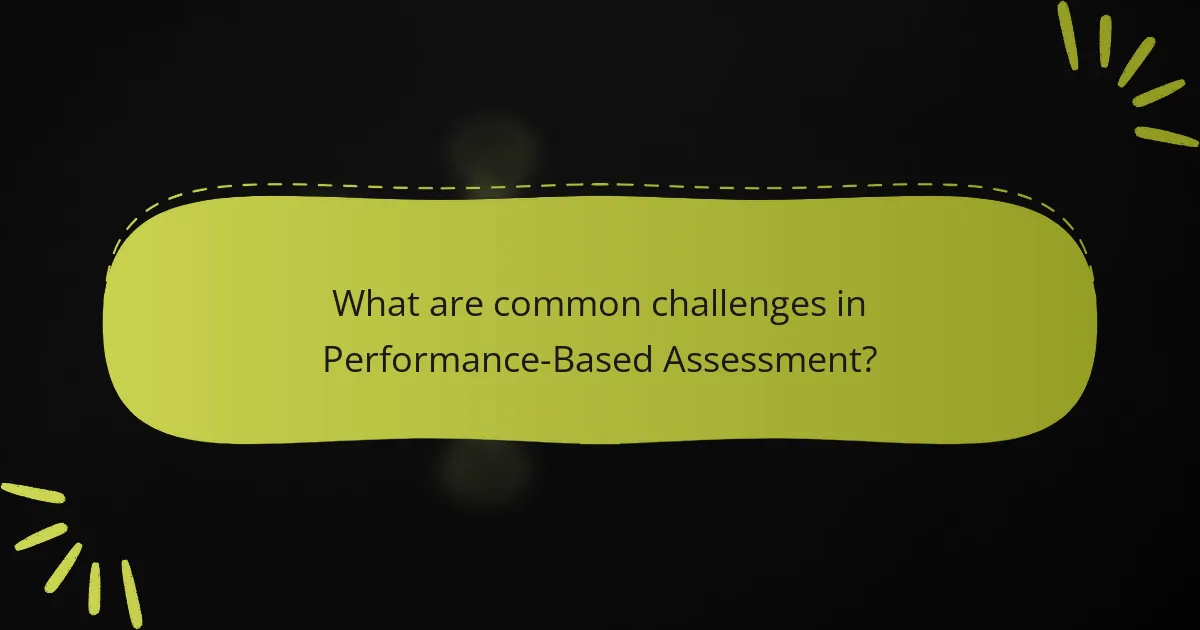
What are common challenges in Performance-Based Assessment?
Common challenges in Performance-Based Assessment include subjectivity in grading, time constraints, and resource requirements. Subjectivity can lead to inconsistent evaluations among assessors. Time constraints often limit the depth of assessment that can be achieved. Resource requirements can strain educational institutions, as they may need specialized materials or training for educators. Additionally, aligning assessments with learning objectives can be complex. These challenges can hinder the effectiveness of Performance-Based Assessments in accurately measuring student understanding and skills.
What obstacles do educators face when adopting Performance-Based Assessment?
Educators face several obstacles when adopting Performance-Based Assessment (PBA). One significant challenge is the lack of training in PBA methodologies. Many educators are accustomed to traditional assessment methods and may struggle to implement new practices effectively.
Additionally, the time required to develop and evaluate performance-based tasks can be a barrier. Educators often have limited time to create assessments that align with curriculum standards while ensuring they are meaningful and rigorous.
Another obstacle is the need for clear assessment criteria. Without well-defined rubrics, educators may find it difficult to assess student performance consistently. This can lead to subjectivity in grading, which undermines the reliability of the assessment.
Furthermore, institutional support is crucial. Many educators report a lack of administrative backing for PBA initiatives. This can lead to feelings of isolation and uncertainty in implementing innovative assessment practices.
Lastly, resistance from students and parents can hinder the adoption of PBA. Some students may prefer traditional testing formats, while parents might be unfamiliar with performance-based approaches. This resistance can create additional pressure on educators as they navigate the transition to new assessment strategies.
How can teachers overcome resistance to Performance-Based Assessment in their schools?
Teachers can overcome resistance to Performance-Based Assessment by providing clear communication about its benefits. They should explain how it enhances student engagement and learning outcomes. Training sessions can help teachers understand the assessment’s implementation. Collaborating with colleagues fosters a supportive environment for sharing best practices. Incorporating feedback from stakeholders builds trust and acceptance. Demonstrating successful case studies can alleviate concerns. Regularly addressing misconceptions helps clarify the assessment’s purpose. Research shows that effective implementation increases teacher buy-in and student success.
What best practices can enhance the effectiveness of Performance-Based Assessment?
Best practices that enhance the effectiveness of Performance-Based Assessment include clear criteria, authentic tasks, and timely feedback. Clear criteria ensure that students understand expectations. Authentic tasks relate to real-world scenarios, increasing engagement. Timely feedback helps students improve by identifying strengths and areas for growth. Additionally, involving students in self-assessment fosters ownership of their learning. Training assessors on consistent evaluation methods promotes reliability. Regularly reviewing and updating assessment practices ensures relevance and effectiveness. These practices collectively contribute to a more meaningful assessment experience for students.
How can collaboration among educators improve Performance-Based Assessment strategies?
Collaboration among educators can significantly enhance Performance-Based Assessment strategies. When educators work together, they can share best practices and innovative ideas. This exchange leads to the development of more effective assessment tools. Collaborative efforts also promote a unified approach to teaching standards. Research indicates that teamwork among educators improves student outcomes. A study by Vescio, Ross, and Adams (2008) found that collaborative professional development positively impacts teaching effectiveness. Additionally, collaboration fosters a supportive environment for sharing feedback. This continuous improvement cycle ultimately benefits students’ learning experiences.
What resources are available for teachers to improve their Performance-Based Assessment techniques?
Teachers can access various resources to enhance their Performance-Based Assessment techniques. Professional development workshops are available through educational organizations such as the National Council of Teachers of Mathematics (NCTM). Online platforms like Edutopia offer articles and videos on effective assessment strategies. Books focused on performance assessment provide in-depth methodologies and case studies. Educational research journals publish studies on best practices in assessment. Collaboration with peers in professional learning communities can foster sharing of techniques and resources. These resources collectively support teachers in implementing effective performance-based assessments.
Performance-Based Assessment in Mathematics evaluates students’ abilities through real-world tasks, emphasizing application skills alongside knowledge. This approach fosters critical thinking, problem-solving, and collaboration, providing a comprehensive view of student capabilities. The article discusses how Performance-Based Assessment differs from traditional methods, its key characteristics, advantages, and the essential components for effective implementation. Additionally, it addresses challenges educators face in adopting this assessment method and offers strategies for enhancing its effectiveness in mathematics education.
